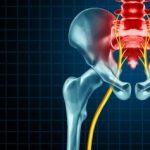Published on April 19, 2022
Medically reviewed by David Ozeri, MD
Pain is a potential symptom of multiple sclerosis (MS) that can significantly interfere with a person’s ability to function and enjoy life. Multiple sclerosis is an autoimmune condition in which the immune system mistakenly attacks the sheath that protects nerve fibers in the central nervous system (CNS).
MS-related pain may arise from nerve damage inflicted by the disease itself or from muscle/soft tissue damage that develops as a person tries to adapt to other MS symptoms, like weakness, balance problems, or walking difficulties.
In this article, we’ll discuss the two main types of pain found in MS. We’ll also review how MS pain can be effectively managed under the care and guidance of your healthcare provider.

Types of MS Pain
To best understand and treat pain in MS, experts have categorized this symptom into these two main types:1
-
Neuropathic pain
-
Musculoskeletal pain
Neuropathic Pain
Neuropathic (nerve-related) pain in MS is caused by the disease itself.
In MS, a person’s immune system attacks the nerve fibers and the protective myelin sheath that surrounds them within their central nervous system. Your CNS is composed of your brain and spinal cord.
When nerve fibers or myelin are damaged, nerve signaling between the CNS and the rest of the body is impaired. This can lead to an array of symptoms, including fatigue, blurry vision, mobility issues, and pain—specifically, neuropathic pain.2
One common type of MS-associated neuropathic pain is dysesthesia. This is a skin sensation that is uncomfortable or painful and often described as burning, tingling, itching, stinging, or crawling feelings.3
Dysesthesia can range in severity from being a mild nuisance to debilitating, interfering with a person’s sleep and ability to work. They are chronic pains, meaning they tend to be long lasting and not typically associated with an MS relapse.
What Is an MS Relapse?
A relapse is when a person with MS experiences new or worsening neurological symptoms followed by a period of symptom improvement or recovery.
Other forms of neuropathic pain in MS are acute. Pain usually begins suddenly and can be part of an MS relapse.
Common examples of acute neuropathic pain in MS include:
- The “MS hug” causes a squeezing or tightening sensation around your torso. It’s caused by MS-related damage to the sensory nerve pathways in your spinal cord.
- Lhermitte’s sign is an electrical shock-like sensation that runs down your spine and is triggered by bending your neck forward. It’s caused by MS-related damage to your upper spine.
- Optic neuritis is a common first manifestation of MS and refers to inflammation of one of your two optic nerves. Symptoms include pain with eyeball movement and loss or blurring of vision.4
- Trigeminal neuralgia causes electric shock-like facial pain. It can be an early symptom of MS, even before the disease is diagnosed.5
Musculoskeletal Pain
Musculoskeletal pain is caused by muscle or soft tissue injury. Unlike neuropathic pain, it’s not a direct result of MS nerve damage. Instead, musculoskeletal pain occurs from how a person compensates for or manages their MS symptoms, like muscle weakness, numbness, or walking/balance difficulties.
For example, you may walk a certain way if you have a weak or numb foot. Over time, your compensated gait can put abnormal stress on certain muscles and joints, like those in your hip, causing pain.
Likewise, if you have fatigue or mobility issues, you may develop lower back pain from sitting for extended periods. Inactivity can also contribute to poor posture and weakness, which may then lead to neck pain and falls, respectively.6
Spasticity is another MS symptom. With spasticity, your muscles become tight or abnormally stiff as a result of MS-related damage within the pathways that carry motor (movement) signals.
While muscle spasms and tightening can be painful, spasticity may also aggravate your joints as the muscles surrounding them are pulled or tugged.7 Spasticity can also cause you to alter your gait or position in a wheelchair, resulting in muscle overuse, injury, and/or pain.
Pain Frequency
How Often Does MS Cause Pain?

Research suggests pain affects anywhere between 30% and 80% of patients living with MS.8 This percentage range is likely broad because pain is a subjective, unique experience, which can make it difficult to measure.
Keep in mind that MS was once considered a painless disease. While we have come a long way in recognizing pain as a real and potentially disabling symptom of MS, it still may be overlooked by those within the healthcare community.
Pain Severity
Not everyone with MS has pain. For those who do, the severity varies considerably.

In some cases, MS-related pain can be intermittent and managed well with relatively simple measures like applying a cold compress, stretching, or temporarily using a mobility assistive device (e.g., brace or scooter).
For others though, their pain may significantly affect their quality of life. Pain may prevent them from sleeping well, working, or performing household tasks.
Unfortunately, the negative impact of pain can then snowball into more problems, including social isolation, depression, and worsening of other MS symptoms (e.g., fatigue and immobility).9
Managing MS Pain
When devising your pain management plan, your MS provider will consider several factors like the type and severity of your pain and whether it’s acute or chronic. Personal preference and your response to previous pain management therapies are also key considerations.
Pharmacological Therapies
There are several classes of medications used to treat MS pain.10

Neuropathic pain may be treated with drugs that help calm down nerve firing. Such drugs include:
- Certain anti-seizure medications like Neurontin (gabapentin) and Lyrica (pregabalin)
- Certain antidepressants like Elavil (amitriptyline) or Cymbalta (duloxetine)
If your pain is caused by an MS relapse, your healthcare provider may prescribe a corticosteroid. Corticosteroids are strong anti-inflammatory drugs that can be given intravenously (through your vein), as with Solumedrol (methylprednisolone), or taken by mouth, as with prednisone.
Musculoskeletal pain can be soothed with an over-the-counter (OTC) pain medication like Tylenol (acetaminophen) or nonsteroidal anti-inflammatory drugs (NSAIDs) like Motrin or Advil (ibuprofen).
Are Tylenol and Motrin Safe for Everyone?
Tylenol and Motrin (and other NSAIDs) should be avoided or used cautiously in people with certain medical conditions. Always talk with your healthcare provider before taking any medication.
If the pain is related to spasticity, a muscle relaxant like Kemstro (baclofen) or Zanaflex (tizanidine) may be prescribed. Baclofen is unique in that it can also be administered intrathecally (delivered directly into your spinal fluid using a pump device).
Botox (onabotulinumtoxin A) injections may also help decrease spasticity in MS.
What to Know About Multiple Sclerosis (MS) Pain Medication
Complementary Therapies
In addition to medication, various complementary therapies may help ease MS-related pain.

Examples of such therapies are:
- Acupuncture: Acupuncture is a traditional Chinese healing practice in which thin needles are inserted into the skin at specific points believed to help channel energy in the body. This therapy may be especially beneficial for managing arm and leg pain and spasticity.11
- Massage: A trained massage therapist uses their hands to knead various muscles and other soft tissues in the body. Massage has been found to improve both pain and fatigue in patients with MS.12
- Cannabinoids: The compounds tetrahydrocannabinol (THC) and cannabidiol (CBD) are found naturally in the cannabis plant, Cannabis sativa, and may help alleviate spasticity and neuropathic pain in MS.13
Other complementary therapies you may consider for soothing your pain include:
- Yoga,
- Aquatic (water) therapy,
- Physical therapy,
- Hypnosis,
- Meditation.
Be mindful that choosing the right combination of therapies is often a trial and error process. It may take some time as you sort through what treatments help you feel better and what fits into your lifestyle.
Summary
Many people living with MS experience neuropathic and/or musculoskeletal pain. Neuropathic pain in MS is caused by damaged myelin and nerve fibers, whereas musculoskeletal pain is muscle or soft tissue damage caused by a person trying to adapt to their MS symptoms.
The management of pain in MS typically involves a combination of medication and complementary therapies.
By Colleen Doherty, MD
Colleen Doherty, MD, is a board-certified internist living with multiple sclerosis.
Video: “Rehabilitation of the patients with Multiple Sclerosis”
Multiple Sclerosis. Exercises for stretching and improving body flexibility and joint mobility, reducing tone.
For additional information about Rehabilitation of the patients with Multiple Sclerosis you can watch a video demonstrating exercises and rehabilitation recommendations.

Check out the demo version of our sets of exercises for Multiple Sclerosis on YouTube
You can find more information about Multiple Sclerosis in our Blog.
Our website presents the following sets of exercises for the rehabilitation of the patients with Multiple Sclerosis:
-
MULTIPLE SCLEROSIS. EXERCISES FOR STRETCHING AND IMPROVING BODY FLEXIBILITY AND JOINT MOBILITY, REDUCING TONE
-
MULTIPLE SCLEROSIS. EXERCISES TO STRENGTHEN THE MUSCULOSKELETAL AND MUSCULAR SYSTEM, ENDURANCE
-
MULTIPLE SCLEROSIS. EXERCISES TO IMPROVE COORDINATION, BALANCE AND GAIT
-
MULTIPLE SCLEROSIS. STRETCHING AND WORKING WITH A MASSAGE ROLLER. ADVANCED STAGE OF REHABILITATION
Conclusion
Managing MS pain requires an individualized approach. When talking with your neurologist or other MS healthcare provider about your pain, try to explain as much as you can about your pain—how it feels, where it’s located, and how severe it is. Giving examples of how your pain affects your daily routine or mood is often helpful.
Also, it’s important to not assume that any pain in your body is from MS. There may be something else going on. Be sure to seek medical care for any new, persistent, or severe pain.
FREQUENTLY ASKED QUESTIONS:
1. Do psychosocial factors play a role in pain?
Research suggests that psychosocial factors like having a negative belief about pain or avoiding activity may affect the severity of a person’s pain and how it interferes with their daily functioning.14
2. Where does MS pain usually occur?
MS pain can occur throughout the body, including the skin, face, arms, hands, legs, feet, and trunk.
If the pain is related to nerve damage from MS (called neuropathic pain), the location of the pain tends to correlate with the area of the central nervous system that is being attacked by the person’s immune system. For instance, MS-related damage to the spinal cord may result in a painful banding sensation felt around the chest (called MS hug).
3. Does MS pain get worse with activity?
Research suggests that exercise can help alleviate pain in patients with MS. If you have MS-related pain, it’s best to talk with your MS healthcare provider or physical therapist to ensure your exercise regimen is safe and beneficial for you.15
Sources
Verywell Health uses only high-quality sources, including peer-reviewed studies, to support the facts within our articles. Read our editorial process to learn more about how we fact-check and keep our content accurate, reliable, and trustworthy.
- National MS Society. Pain and Itching.
- Khan N, Smith MT. Multiple sclerosis-induced neuropathic pain: pharmacological management and pathophysiological insights from rodent EAE models. Inflammopharmacology. 2014;22(1):1-22. doi:10.1007/s10787-013-0195-3
- Shumway NK, Cole E, Fernandez KH. Neurocutaneous disease: neurocutaneous dysesthesias. J Am Acad Dermatol. 2016;74(2):215-28; quiz 229-30. doi:10.1016/j.jaad.2015.04.059
- Kale N. Optic neuritis as an early sign of multiple sclerosis. Eye Brain. 2016;8:195–202. doi:10.2147/EB.S54131
- Fallata A, Salter A, Tyry T, Cutter GR, Marrie RA. Trigeminal neuralgia commonly precedes the diagnosis of multiple sclerosis. Int J MS Care. 2017;19(5):240-246. doi:10.7224/1537-2073.2016-065
- Prosperini L, Castelli L. Spotlight on postural control in patients with multiple sclerosis. Degener Neurol Neuromuscul Dis. 2018;8:25–34. doi:10.2147/DNND.S135755
- American Association of Neurological Surgeons. Spasticity.
- Urits I, Adamian L, Fiocchi J et al. Advances in the understanding and management of chronic pain in multiple sclerosis: a comprehensive review. Curr Pain Headache Rep. 2019;23(8):59. doi:10.1007/s11916-019-0800-2
- Kahraman T, Özdoğar AT, Ertekin O, Özakbaş S. Frequency, type, distribution of pain and related factors in persons with multiple sclerosis. 2019;28:221-225. doi:10.1016/j.msard.2019.01.002
- Chisari CG, Sgarlata E, Arena S, D’Amico E, Toscano S, Patti F. An update on the pharmacological management of pain in patients with multiple sclerosis. 2020;21(18):2249-2263. doi:10.1080/14656566.2020.1757649
- Khodaie F, Abbasi N, Motlasgh AHK, Zhao B, Moghadasi AN. Acupuncture for multiple sclerosis: A literature review. Mult Scler Relat Disord. 2022;60:103715. doi:10.1016/j.msard.2022.103715
- Salarvand S, Heidari ME, Farahi K, Teymuri E, Almasian M, Bitaraf S. Effectiveness of massage therapy on fatigue and pain in patients with multiple sclerosis: A systematic review and meta-analysis. Mult Scler J Exp Transl Clin. 2021;7(2):20552173211022779. doi:10.1177/20552173211022779
- Rice J, Cameron M. Cannabinoids for treatment of MS symptoms: state of the evidence. Curr Neurol Neurosci Rep. 2018;18(8):50. doi:10.1007/s11910-018-0859-x
- Harrison AM, Silber E, McCracken LM, Moss-Morris R. Beyond a physical symptom: the importance of psychosocial factors in multiple sclerosis pain. Eur J Neurol. 2015;22(11):1443-52. doi:10.1111/ene.12763
- Demaneuf T, Aitken Z, Karahalios A. Effectiveness of exercise interventions for pain reduction in people with multiple sclerosis: a systematic review and meta-analysis of randomized controlled trials. Arch Phys Med Rehabil. 2019;100(1):128-139. doi:10.1016/j.apmr.2018.08.178


















